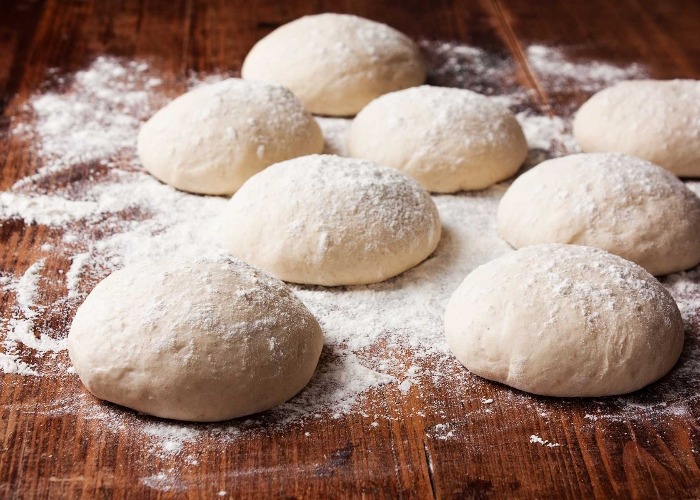Neapolitan pizza dough recipe

There's nothing quite like freshly-made pizza dough that's perfectly crispy yet chewy. This recipe makes 6–7 balls of dough, enough for 6–7 pizzas. Note: the prep time doesn't include resting or proving.
Ingredients
- 1 kg '00' flour (we recommend Caputo 'blue')
- 2 g fresh yeast
- 620 ml tepid water
- 30 g fine sea salt
- 2.2 lbs '00' flour (we recommend Caputo 'blue')
- 0.1 oz fresh yeast
- 21.8 fl oz tepid water
- 1.1 oz fine sea salt
- 2.2 lbs '00' flour (we recommend Caputo 'blue')
- 0.1 oz fresh yeast
- 2.6 cups tepid water
- 1.1 oz fine sea salt
Details
- Cuisine: Italian
- Recipe Type: Pizza
- Difficulty: Easy
- Preparation Time: 30 mins
- Cooking Time: 0 mins
- Serves: 2
Step-by-step
- Make a mountain of flour in the middle of the table. Using your fist, make a deep well in the middle of the flour, exposing the surface of the table (turning your mountain into a moon crater).
- Crumble the yeast into the tepid water. Use your good hand to mash up the yeast in the water until it has dissolved. Fill your crater of flour with a third of the yeast/water mix. Using your fingertips, start making very small circular motions to combine the flour and water.
- Start dragging in some more flour to the mix, by ‘undercutting’ the walls of the crater with your fingertips. As you do this the mixture in the middle will become thicker. Once it reaches the consistency of porridge you need to add a bit more water. Don’t let it get too thick; if it starts to form a dough too soon it becomes difficult to incorporate the rest of the water. Keep dragging in a little flour to thicken the mix, then pouring a little bit more water in to loosen it, until you have used up all the water.
- Sprinkle the sea salt over the mixture while it’s still very wet to ensure it dissolves and disperses evenly throughout the dough.
- Now use both hands to push the remaining flour from the outside into the middle. Fold and press the mix until all the flour is absorbed and a dough comes together. If you have a dough scraper it really helps get everything off the table, but you can improvise with a paint scraper, spatula or knife.
- Work the gluten by kneading the dough. Use the heel of your hand to stretch out the dough and roll it back up, while the other hand acts like an anchor. You’ll be able to see the strands of gluten stretching, breaking, being put back together and becoming stronger. Continue this for about 8 minutes until the dough becomes smooth and glossy. It should also feel tighter and elastic.
- Let the dough have a 10-minute rest to relax the gluten. Cover the dough with a damp cloth or some clingfilm (plastic wrap) to keep the air from drying it out.
- Then divide your bulk of dough into 6–7 individual portions. We recommend 230g (8oz) dough balls for 10-inch pizzas. Ensure your dough balls are neatly shaped – pinched at the bottom and tight on the top – then place them in a tray or container 3cm (1in) apart. Cover with a tight lid or clingfilm (plastic wrap).
- Now you can relax. The yeast will take over from here. Leave the dough at room temperature for approximately 6 hours until it expands to almost double its size, then store in the fridge overnight. The next day remove the dough from the fridge for 1–2 hours and bring it back to room temperature before making your pizzas.
This recipe is from PIZZA: History, recipes, stories, people, places, love by Thom & James Elliot (Quadrille, £20). Book photography © Dave Brown.
Recipe image: V. Matthiesen/Shutterstock
You might also like:
Comments
Be the first to comment
Do you want to comment on this article? You need to be signed in for this feature